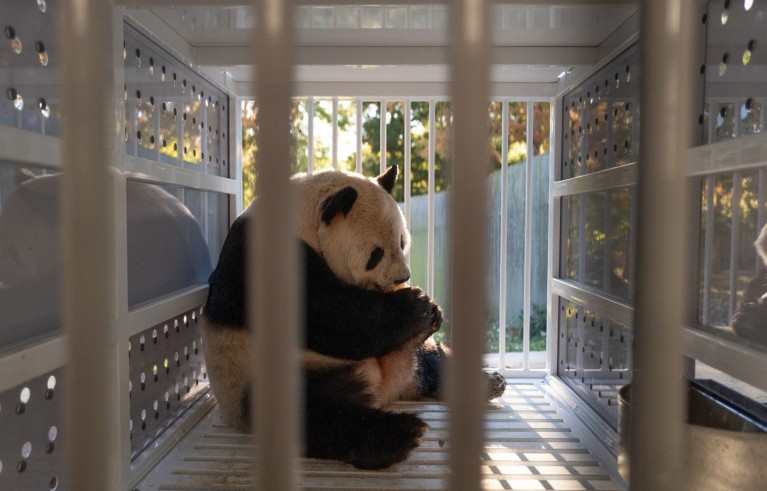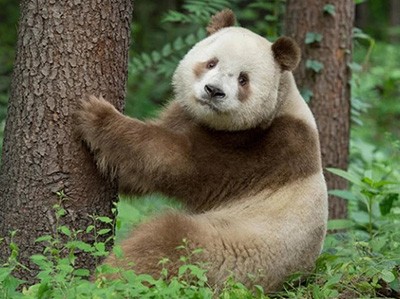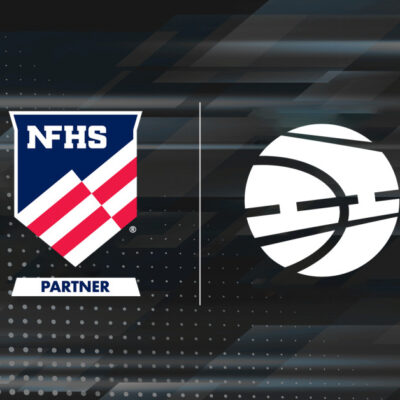Last week, Brandie Smith joined US First Lady Jill Biden and Smithsonian secretary Lonnie Bunch to announce the arrival of two giant pandas to the Smithsonian National Zoo in Washington DC. The animals are due to arrive by the end of the year, more than a year after Smith and her colleagues bade farewell to the zoo’s last panda family.
As parents with empty nest syndrome will confirm, it is often only when you go into your grown-up child’s abandoned bedroom for the first time that their departure really hits you. It was a similar feeling for Smith when she went into the panda house at the Smithsonian’s National Zoo and Conservation Biology Institute one day last November.
A few days before, Smith, who is the director of the zoo and institute, joined colleagues in saying goodbye to the zoo’s three giant pandas (Ailuropoda melanoleuca) — Mei Xiang, Tian Tian and their cub, Xiao Qi Ji, which had been born three years earlier by artificial insemination. The time had come for the trio to be sent back to China. Their departure was an especially sad day, because Mei Xiang was the zoo’s first female panda whose cubs survived longer than a few days after birth.
The two older pandas had been at the zoo since 2000 as part of a loan agreement with the Chinese government, which originally ended in 2020 but was extended for another three years. The zoo’s panda presence dates back to 1972, when the Chinese government gifted the United States two animals after US president Richard Nixon’s landmark trip to the communist country, coining the term panda diplomacy. Other zoos and countries followed suit.
Writing in The Washington Post two days after the pandas departed, Bunch and Ellen Stofan, Smithsonian’s undersecretary for science and research, said that the animals were “a vital source of cultural diplomacy” and described them as “a bridge between the American people and the Chinese people”.
For Smith and her team, questions of politics were far from their minds in the frenetic days before the pandas’ departure. Instead, the zookeepers were focused on preparing the animals for the journey and ensuring a smooth transition to their new habitat. In the weeks before the pandas left for China, staff members familiarized them with the crates they would be travelling in, persuading them to walk through the boxes and encouraging them to spend a short time inside. The pandas made the 19-hour journey by aeroplane, accompanied by three members of zoo staff and around 100 kilograms of bamboo. After landing in Chengdu, southwestern China, they were taken to Shenshuping Panda Base campus in Wolong, where they spent 30 days in quarantine before being allowed into the rest of the Wolong Panda Reserve.

Giant panda Tian Tian enjoys a frozen treat in his travel crate.Credit: Roshan Patel/Smithsonian’s National Zoo
“Shipping three large herbivores halfway round the world when there is no margin for error is a huge undertaking. There are so many moving parts and the entire focus is on the well-being of these animals,” says Smith, who has held her current post since 2021. “It didn’t really hit me until I went into the panda house a couple of days after they had left — that was the saddest time,” she adds.
Coming full circle
It was particularly poignant for Smith, because her first job at the Smithsonian’s zoo was as giant panda curator. When she joined in 2008, she had no experience with giant pandas — a creature she describes as “pure joy” — although she was an experienced animal conservationist. She studied biology at the Indiana University of Pennsylvania and then did a master’s degree in the genetic management of endangered species at Clemson University in South Carolina. Her career caring for animals began in earnest when she got a job as a rhino keeper at the Dallas Zoo in Texas.
Smith stayed in Dallas for a couple of years, before her research into the management of endangered species led her to the Association of Zoos and Aquariums in Silver Spring, Maryland, where she spent around ten years and eventually became the vice-president of animal conservation. The association determines standards in areas such as animal care, conservation and education for its member organizations. In 2010, Smith gained her PhD from the University of Maryland, College Park. Her research focused on the management of large groups of mammals, for which breeding pairs or individuals are difficult to identify or control.
When the job at the Smithsonian’s zoo came up, Smith jumped at the chance to work at such an august institution and with such an iconic animal as the giant panda (see ‘Quick-fire questions’).
The zoo, founded in 1889, sits in a 66-hectare park in the heart of the US capital and is home to more than 2,200 animals. Smith’s remit includes oversight of the zoo’s conservation research institute in Front Royal, Virginia, as well as field stations in 30 countries. The zoo is part of the Smithsonian Institution, the world’s largest museum, education and research complex.
Breeding difficulties
One of Smith’s first jobs was to look at the panda breeding programme. In 2005, Mei Xiang and Tian Tian had a cub called Tai Shan, which moved to China in 2010. He was the first panda born at the zoo to survive for more than a few days — but after his birth the breeding programme hit a brick wall.
Pandas have a notoriously difficult reproductive cycle — females are capable of conceiving for only 24 to 72 hours a year and, because they are solitary animals, males and females are brought together in captivity only during the breeding window. However, Mei Xiang has never conceived naturally. Female pandas can give birth to two cubs, although usually only one survives, and they are capable of breeding only every other year. At most, a female panda can produce eight cubs during her lifetime.
“We had been doing things in a certain way for a long time. We were following certain protocols that were based on what other zoos were doing — and these protocols were good but we weren’t having any success,” says Smith.
Working Scientist career profiles
The scientific protocols included measuring levels of oestrogen and progesterone in Mei Xiang’s urine to test when she was in peak oestrus and when she was ovulating. The zoo’s reproductive specialists also played matchmaker by searching databases for the best genetically matched mate for Mei Xiang.
“So we sat down as a team and broke things down. Why were things not working? We decided to look at Mei Xiang’s behaviour, rather than thinking about how giant pandas behave in general. And we altered the protocols so they were more specific for her,” she says.
Smith says there was “no magic solution” to achieve a viable pregnancy: the panda team realized that Mei Xiang likes to be left alone, so instead of doing invasive checks they let her do what came naturally after she had been inseminated.
In 2012, Mei Xiang gave birth to a female cub, which died after seven days. But in 2013, Mei Xiang gave birth to a healthy female, Bao Bao, followed by a male called Bei Bei in 2015, both of which are now in reserves in China. Bei Bei had a twin that died four days after birth. Xiao Qi Ji was born in 2020.
Changing priorities
Despite the eyes of the world being on the zoo — literally, through the zoo’s panda webcam — Smith did not feel any personal pressure for Mei Xiang to produce a healthy cub. Uncertainty is part of the job, she says. “Scientific training helps you think in a certain way, so that you know how to ask the questions to get to a solution. And the whole thing about my job is there are no answers. And we try at least one impossible thing every day.”
“You have to be flexible, you have to understand data, you have to be willing to live with uncertainty and risk,” she says.
Smith’s role has a large administrative component, including how to cope with the loss of revenue after shutdowns in response to the COVID-19 pandemic. Last year, visitor numbers exceeded pre-pandemic levels, with 1.9 million people coming to look at the animals, compared with 1.8 million in 2019, but Smith thinks the departure of the crowd-pleasing pandas will probably affect numbers in the long term.
“I know that the panda cam was the most visited site of the Smithsonian Institute as a whole,” she says.
Genetics solves mystery of rare brown pandas after 40 years
Her work also includes a strong academic focus. The zoo has research programmes both in the United States and abroad. Earlier this year, Smith visited the Smithsonian Tropical Research Institute in Panama City to learn more about its conservation programme, which aims to rescue colonies of amphibians that are at extreme danger of extinction. And last year, she was in Kenya looking at the zoo’s research on the migration of giraffes (Giraffa sp.). Improved technology is enabling researchers to track the elegant beasts’ movements in a bid to stop a sharp decline in their numbers. This knowledge will enable scientists to work out where to establish patrols to stop poaching and at which communities to target education programmes.
As Smith has risen through the ranks — from panda curator to head of animal care to deputy director and now director — she has less hands-on time with animals. But their welfare is still a huge focus, says animal welfare and research manager Betsy Herrelko, who has worked closely with Smith since joining in 2016.
Herrelko says that Smith has a “fierce dedication” to the animals and the people who study and care for them.
“If you look at her calendar, you’ll see how much time she spends looking for the resources we need to do our jobs to the best of our ability. It’s not fun work. I’m sure she misses being with the animals, but she’s doing it for the greater good,” she says.
Smith is adamant that zoos have changed immeasurably since she started visiting her local zoo in Pittsburgh, Pennsylvania, as a child in the 1970s.
“In the past 50 years, we’ve seen an increasing focus on conservation but also a better understanding of what different species need for us to ensure all their needs are met behaviourally, socially, psychologically and physically,” she says.
And she sees zoos as an important way for people who would never be able to see animals in the wild to connect with the natural world.
“Zoos can do things nobody else can,” she adds. Animals such as condors or scimitar-horned oryx (Oryx dammah) survive today because zoos bred them and reintroduced them into the wild.
“We can literally save animals from extinction. I think that’s pretty cool,” she says.






